Despite this casual air, almost all presidential family portraits nonetheless display some air of formality. Parents sit upright. Small children may be on laps, but seated, not sprawling. Standing members don't lounge, but lean gracefully on the backs of chairs or on a shoulder.
 |
By Edward Savage
Oil on Canvas
1789-1796
Andrew W. Mellon Collection
National Gallery of Art
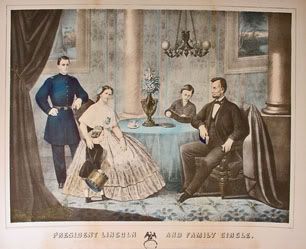 |
Respectfully Dedicated To The People Of The United States
Lithograph by A. Hohenstein.
Published by John Smith, 1865.
18 5/8 x 24 3/4.
[An interesting anecdote is that this lithograph was after a painting of Lincoln and his family by Francis Bicknell Carpenter, where he is reading to his son Tad. In Hohenstein's lithograph, Tad reads to his father.]
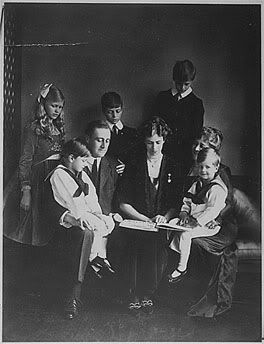 |
In Washington D.C.
June 12, 1919
(Picture courtesy the Franklin D. Roosevelt Library)
 |
By Greta Kempton
1952
The cut-off point for formal turning to casual seems to be the late 1950s. The reasons for this are complex, although they are mostly to do with the decline in authority and hierarchy in modern life, which brought forth the tumultuous 1960s. The Truman family portrait of 1952 subtly shows this change, where despite the parents' still formalized presentation, the young member of the family, the daughter, is sitting casually perched on the arm of her mother's chair.
The 1959 family portrait of Vice President Nixon has his younger daughter Julie leaning on her sister Tricia, with her arm draped around Tricia's shoulder. And rather than placing her hand on her father's arm, she seems to be clutching on to it. This is very different from the gentle hand President Roosevelt's son places on his father's shoulder, or even the soft placement of Margaret's hand on the back of the chair. Still, while Julie is less restrained, all the rest are sitting upright. Perhaps such informality can be allowed for a young child. A later portrait, with the daughters as grown young women, shows the family in a more formal air (despite those 1960s mini-skirts).
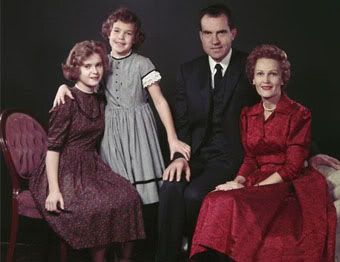 |
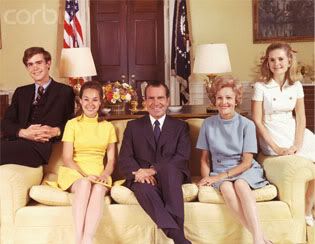 |
The sprawling, informal family portraits began with the Kennedys' 1962 Christmas photo, where the extended family, which included Jacqueline Kennedy's sister and her family, were part of the unofficial portrait that was available for the public. Previously, portraits were of the nuclear family: parents and children (without their spouses). And family members were carefully positioned to compose a structured tableau. Was it the catholic nature of the Kennedy family that allowed this departure from tradition?
The Reagan, and especially the Bush, families follow this example of extended family inclusion, albeit with somewhat more formal photographs.
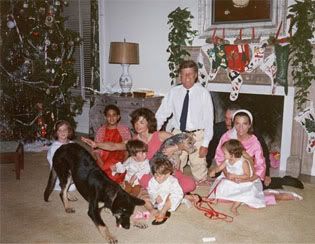 |
on Christmas Day at the White House Dec. 25, 1962.
Caroline Kennedy, John F. Kennedy Jr. , Anthony Radziwill ,
Prince Stanislaus Radziwill, Lee Radziwill, Ann Christine Radziwill.
(John F. Kennedy Library/ Getty Images)
A later Kennedy "family portrait" is even more casual, where instead of the formal interior setting of the White House, the Kennedys posed at the porch of their Cape Cod vacation home, where Jackie is in a summer dress, and President Kennedy is in jeans and a shirt with the sleeves rolled up.
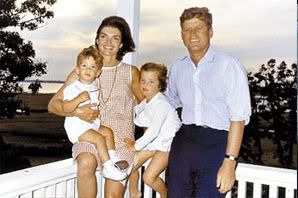 |
Hyannis Port, August 4, 1962
This is perhaps one of the first photographs of children clutching at their mother which we will see in an exaggerated and inelegant form in the Obama photographs. But, Caroline seems to be holding on to her mother to avoid tumbling off her somewhat unstable perch.
The Kennedys also posed in an informal manner sitting on stairs for a Christmas card family portrait, to have been released in December 1963, but which was cancelled after President Kennedy's assassination. Little John Kennedy is bare foot, and is held tightly (and somewhat clumsy) by his president father. The photo is endearing, but still I wonder at the (uncomfortable) casualness of it all.
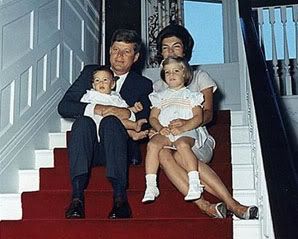 |
photographed just before President Kennedy's assassination
Portraits where all the protagonists are standing were rare in the past. I think that such portraits are imposing, especially if there is a large number of people. They are not necessarily formal. I'm not sure why this "tradition" started, and it seemed to have been initiated by the Fords, and later on followed by the Reagans.
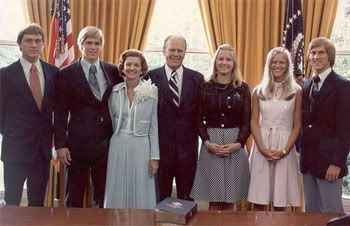 |
Left to right:
Son Steven Ford, son John Ford,
First Lady Betty Ford, President Gerald Ford,
daughter Susan Ford,
and daughter-in-law Gayle Ann Ford
and her husband, Michael Ford.
The Reagan family also opted to stand for their Christmas photo in 1983. Despite the "extended" family of children's spouses, with only two children and no grandchildren, this portrait is less of a sprawl compared to the Kennedy portrait.
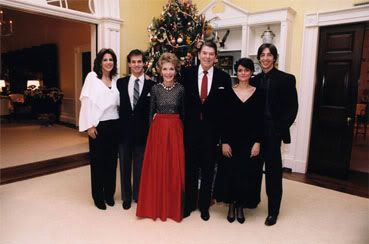 |
A sprawling Bush family portrait, which still has a formal air, includes:
President George W. Bush, first lady Laura Bush, former first lady Barbara Bush and former President George H.W. Bush sit surrounded by family in the Red Room of the White House January 6, 2005 in Washington, DC. Friends and family joined former President Bush and Barbara Bush in celebrating their 60th wedding
 |
The Clintons avoid chaos in numbers in their family portraits because there is only three of them. Yet, Chelsea is too old to be sitting at her parents' feet (and wearing such a short skirt), and Hillary opts to perch on the chair's arm. These casual interjections distract from their well-groomed appearance. It's as though they want to contain casual and formal in one photograph.
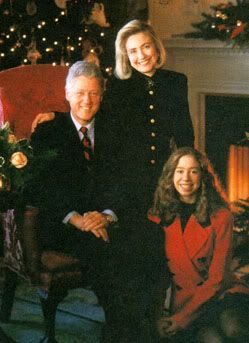 |
And finally to the clutching Obamas:
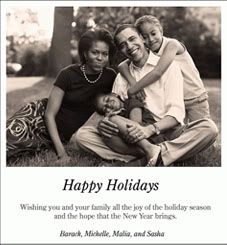 |
The caption reads:
Happy Holidays [not Merry Christmas]
Wishing you and your family all the joy of the holiday season [no mention of Christmas, again. "Holiday season" uncapitalized...] and the hope that the New Year brings ["New Year" capitalized].
Barack, Michelle, Malia and Sasha [we are on first-name basis with the president].
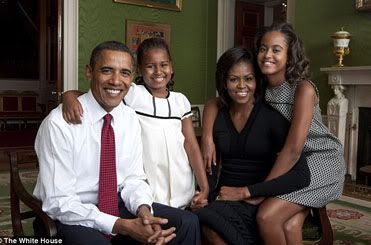 |
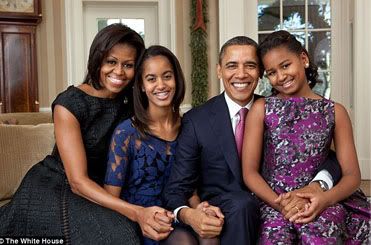 |
The Obamas have released their family portrait, two years after their last one. I blogged about their 2009 portrait here, where I ask:
Why does Michelle allow her daughter to wrap herself around her like that?I found the "wrapping around" odd behavior, despite the relaxed, family-oriented rather than formal, intent of the photograph. But, the collection of other presidential family portraits I've posted above, and even in the most casual shots, have a certain formality and decorum.
I continue:
What kind of daughter anyway (except for these self-conscious "low-self-esteem" types, who are always looking for attention) behaves like that?I try to answer the question thus:
I think Michelle must be a distant, and not very affectionate mother, for all the talk she does about her daughters. And I think that Malia has to seek that affection.In any case, irrespective of any psychological dynamics that go on within their house, many people avoid bringing them to the outside. Such an onus is especially placed on the First Family. Granted, modern-day presidential privileges are few, or tainted, such as having images of the couple and its family get taken at the oddest moments. But, such an adroit person as Michelle Obama surely could handle these difficulties. As I showed above, families with deep internal difficulties, including even the Clintons, often put on a brave and solid face before the public. The Obamas seem to just "let it all hang out."